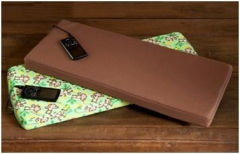Aromatherapy is often touted to help reduce anxiety. The National Institute of Cancer (NCI) says this about it:
A large body of literature has been published on the effects of odors on the human brain and emotions. ... Such studies have consistently shown that odors can produce specific effects on human neuropsychological and autonomic function and that odors can influence mood, perceived health, and arousal. These studies suggest that odors may have therapeutic applications in the context of stressful and adverse psychological conditions.
The NCI (3) looked at a research done with cancer patients using aromatherapy to treat anxiety and other symptoms of cancer. The studies, which included children, show that aroma therapy can be effective - and especially when combined with massage. Here are some of the results. The full results are here.
- Chamomile combined with massage appears to work well.
- Smelling and tasting orange helped with physical symptoms of cancer treatment in children. There was no report on its effect on anxiety.
- Various essential oils (selected by patient) appear to reduce anxiety.
- Bergamat did not work and in fact, increased anxiety in children.
- Lavender did not appear to work as a relaxant in these studies. By the way, there is some evidence that exposure to lavender in boys and men can enlarge mammary glands.
For more information on essensial oils and aromatherapy go to:
- The National Cancer Institute: Aromatherapy and Essential Oils
- A Brief History of Aromatherapy
- Llewellyn's Complete Formulary of Magical Oils by Celeste Rayne Heldstab - A fun, but not evidence-based source of information.
References:
- Chuang K-J, Chen H-W, Liu I-J, et al. The effect of essential oil on heart rate and blood pressure among solus por aqua workers. Eur J Prevent Cardiol, 2012 DOI: 10.1177/2047487312469474
- A synopsis of the above article is at ScienceDaily: Mind&Body: http://www.sciencedaily.com/releases/2012/11/121129093419.htm?utm_source=feedburner&utm_medium=email&utm_campaign=Feed%3A+sciencedaily%2Fmind_brain+%28ScienceDaily%3A+Mind+%26+Brain+News%29
- Study with cancer patients: http://www.cancer.gov/cancertopics/pdq/cam/aromatherapy/healthprofessional/page7
